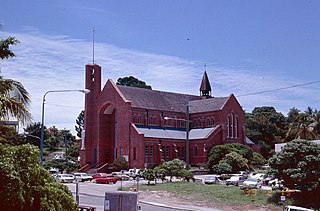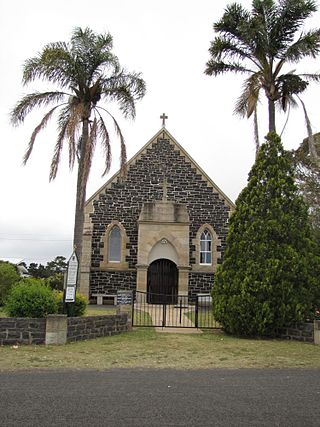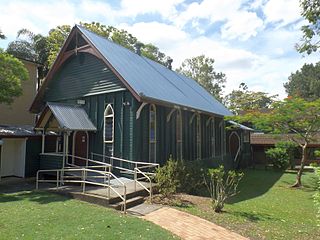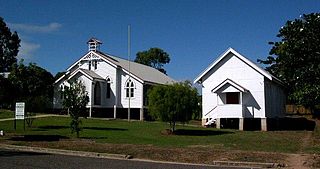
Allenstown is a suburb of Rockhampton, Rockhampton Region, Queensland, Australia. It is situated 1.6 kilometres (0.99 mi) by road south-west of the Rockhampton CBD. In the 2016 census, Allenstown had a population of 2,790 people.

George Dowglas Halford was the second Anglican Bishop of Rockhampton from 1909 until 1920.

St James Cathedral is a heritage-listed cathedral of the Anglican Diocese of North Queensland at 36 Cleveland Terrace, Townsville, City of Townsville, Queensland, Australia. It was designed by Arthur Blacket and was built in 1887 by MacMahon & Cliffe. It was added to the Queensland Heritage Register on 21 October 1992.

St Paul's Anglican Cathedral is an Australian heritage-listed cathedral at 89 William Street, Rockhampton, Rockhampton Region, Queensland. It was designed principally by Annersley Voysey and built from 1883 to 1953. It is also known as St Paul's Church of England and St Paul's Church of England Cathedral. It was added to the Queensland Heritage Register on 21 October 1992. The associated hall and offices were listed on the Queensland Heritage Register on 23 June 2000.

St Matthew's Anglican Church is a heritage-listed church at Beatrice Street, Drayton, once a town but now a suburb of Toowoomba in Toowoomba Region, Queensland, Australia. It was designed by James Marks and built from 1886 to 1887 by Seath, Hobart and Watson. It is also known as St Matthew's Church of England and is the second church of that name in Drayton. It was added to the Queensland Heritage Register on 21 October 1992.

St John's Anglican Church is a heritage-listed church at 153 Cunningham Street, Dalby, Western Downs Region, Queensland, Australia. It is the third church of that name on the site and was designed by Henry James (Harry) Marks and built in the 1920s. It is also known as St John's Church of England. It was added to the Queensland Heritage Register on 14 August 2008.

St Agnes Anglican Church is a heritage-listed churchyard at Ipswich Street, Esk, Somerset Region, Queensland, Australia. It was designed by John Hingeston Buckeridge and built in 1889 by Lars Andersen. It is also known as St Agnes Rectory and Church Hall. It was added to the Queensland Heritage Register on 21 October 1992.

St Andrews Church Hall is a heritage-listed former church and now church hall at 72 Lambert Road, Indooroopilly, City of Brisbane, Queensland, Australia. It was designed by John Hingeston Buckeridge and built from 1889 to c. 1930 by P Christensen. It is also known as Indooroopilly Church of England Sunday School and the temporary St Andrews Church. It was added to the Queensland Heritage Register on 9 July 1993.

Anglican Church of the Good Shepherd is a heritage-listed church at 615 Brookfield Road, Brookfield, City of Brisbane, Queensland, Australia. It was built from 1892 to 1893. It was added to the Queensland Heritage Register on 28 April 2000.

Christ Church Tingalpa and Burial Ground is a heritage-listed former Anglican church at 1341 Wynnum Road, Tingalpa, City of Brisbane, Queensland, Australia. It was built from 1868 to 1993. It is now known as the Pioneer Wedding Chapel. It was added to the Queensland Heritage Register on 2 February 1998.

St Paul's Anglican Church is a heritage-listed church at 124 Brisbane Street, Ipswich, City of Ipswich, Queensland, Australia. It was built from 1855 to 1929. It was added to the Queensland Heritage Register on 21 October 1992.

St Josephs Cathedral is a heritage-listed Roman Catholic cathedral at 170 William Street, Allenstown, Rockhampton, Rockhampton Region, Queensland, Australia. It was designed by Francis Drummond Greville Stanley and built from 1893 to 1982. It was added to the Queensland Heritage Register on 21 October 1992.

St Peter's Anglican Church and Hall is a heritage-listed church at 85 Elm Street, Barcaldine, Barcaldine Region, Queensland, Australia. It was designed by Edwin Hockings and built in 1899. It was added to the Queensland Heritage Register on 21 October 1992.

St Mary's Anglican Church is a State heritage-listed church at 11 Gordon Street, Mount Morgan, Rockhampton Region, Queensland, Australia. It was designed and built in 1888-1889 by Scottish-born Thomas Glen Cornes (1842-1903), superintendent of sawmills and carpenters at the Mount Morgan Gold Mining Company Limited. It was added to the Queensland Heritage Register on 25 August 2000.

St Paul's Anglican Cathedral Hall is a heritage-listed church hall at 89 William Street, Rockhampton, Rockhampton Region, Queensland, Australia. It is adjacent to St Paul's Anglican Cathedral. It was designed by Louis Spier Robertson and built c. 1900. It is also known as St Paul's Anglican Cathedral Offices, St Paul's Anglican Cathedral Parish Hall, and St Paul's Day School (1902-1912). It was added to the Queensland Heritage Register on 23 June 2000.

St John's Anglican Church is a heritage-listed church at 278 Ford Street, Berserker, Rockhampton, Rockhampton Region, Queensland, Australia. It was built in 1912. It was added to the Queensland Heritage Register on 5 August 2003.

Christ Church Anglican Church is a heritage-listed church at Cannon Street, St Lawrence, Isaac Region, Queensland, Australia. It was designed by Alfred Mowbray Hutton and built in 1898 by Newman Brothers. It was added to the Queensland Heritage Register on 27 October 2000.

St John's Anglican Church Precinct is a heritage-listed churchyard at 30-34 Macrossan Street, South Townsville, City of Townsville, Queensland, Australia. It was built from c. 1907 to c. 1911. It was added to the Queensland Heritage Register on 21 October 1992.

St Michael and All Angels Church is a heritage-listed Anglican church at 2-6 Alford Street, Kingaroy, South Burnett Region, Queensland, Australia. It was designed by Colin Deighton and built in 1911. It was added to the Queensland Heritage Register on 17 September 2010.

Allenstown State School is a heritage-listed state school at 13-33 Upper Dawson Road, Allenstown, Rockhampton, Rockhampton Region, Queensland, Australia. It was built in 1884 by Department of Public Works. It was added to the Queensland Heritage Register on 20 September 2019.
























